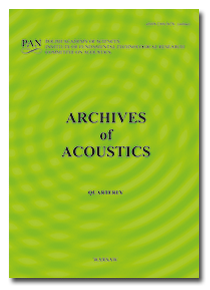Archives of Acoustics,
31, 4(S), pp. 425-429, 2006
The threshold of the residual pitch in three-component inharmonic stimuli
The paper presents the research results of the first effect of pitch shift in three-component
inharmonic complexes. The appearance of this effect is the most important evidence that the
difference tone introduced by the nonlinearity of a hearing system does not influence residual
pitch perception in three-component complexes. The subjects in the adjustment procedure
matched the three-component complexes pitch to the same sensation produced by pure tone.
The subjects listened to three components, the harmonics of 200 Hz, which were equally
shifted in the frequency domain. A 30 Hz shift was applied. The frequency range was 630–4430. The hearing experiments reveal the existence of the threshold of the appearance of the
virtual pitch corresponding near to $F_1 = 200$ Hz. These results are explained using the pitch
perception models based on the Licklider duplex theory and Terhardt’s pitch algorithm.
inharmonic complexes. The appearance of this effect is the most important evidence that the
difference tone introduced by the nonlinearity of a hearing system does not influence residual
pitch perception in three-component complexes. The subjects in the adjustment procedure
matched the three-component complexes pitch to the same sensation produced by pure tone.
The subjects listened to three components, the harmonics of 200 Hz, which were equally
shifted in the frequency domain. A 30 Hz shift was applied. The frequency range was 630–4430. The hearing experiments reveal the existence of the threshold of the appearance of the
virtual pitch corresponding near to $F_1 = 200$ Hz. These results are explained using the pitch
perception models based on the Licklider duplex theory and Terhardt’s pitch algorithm.
Keywords:
pitch perception, residual pitch, residue phenomenon threshold.
Full Text:
PDF
Copyright © Polish Academy of Sciences & Institute of Fundamental Technological Research (IPPT PAN).





